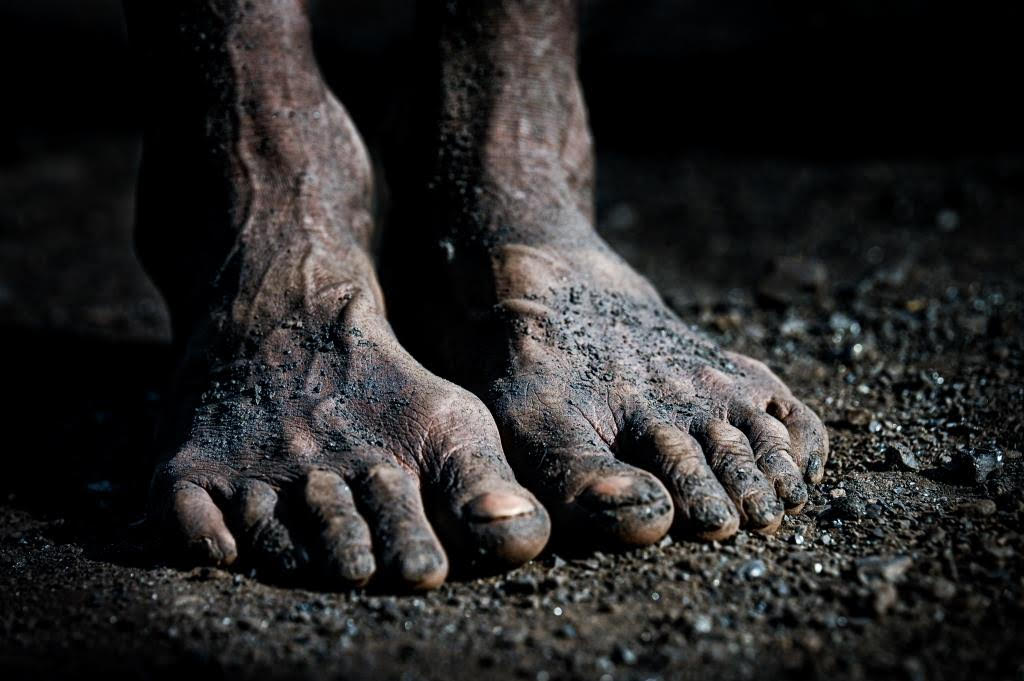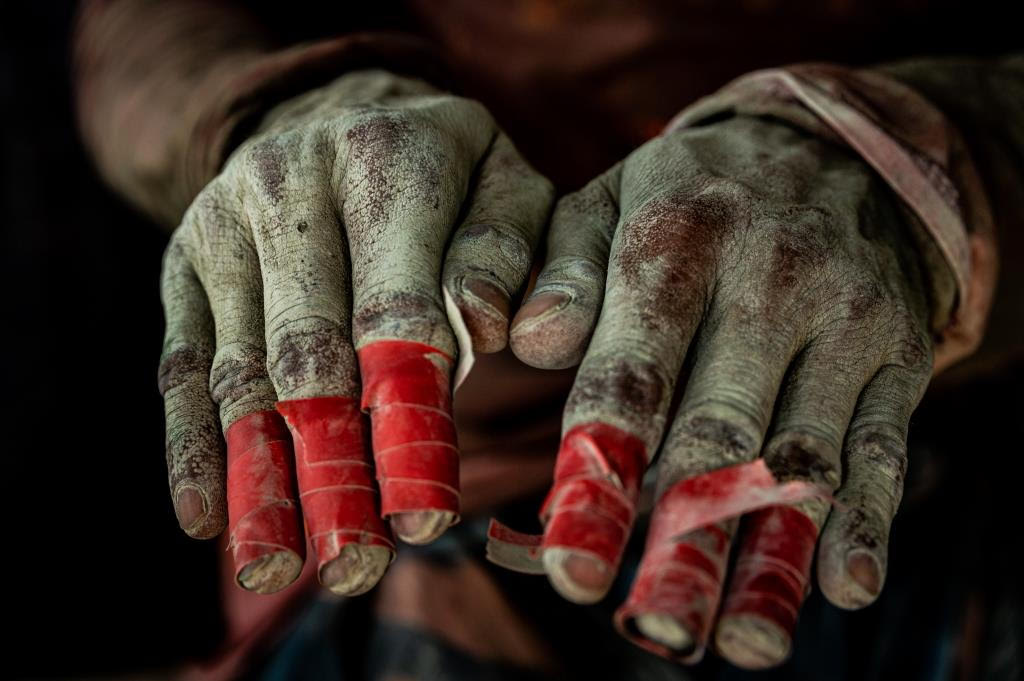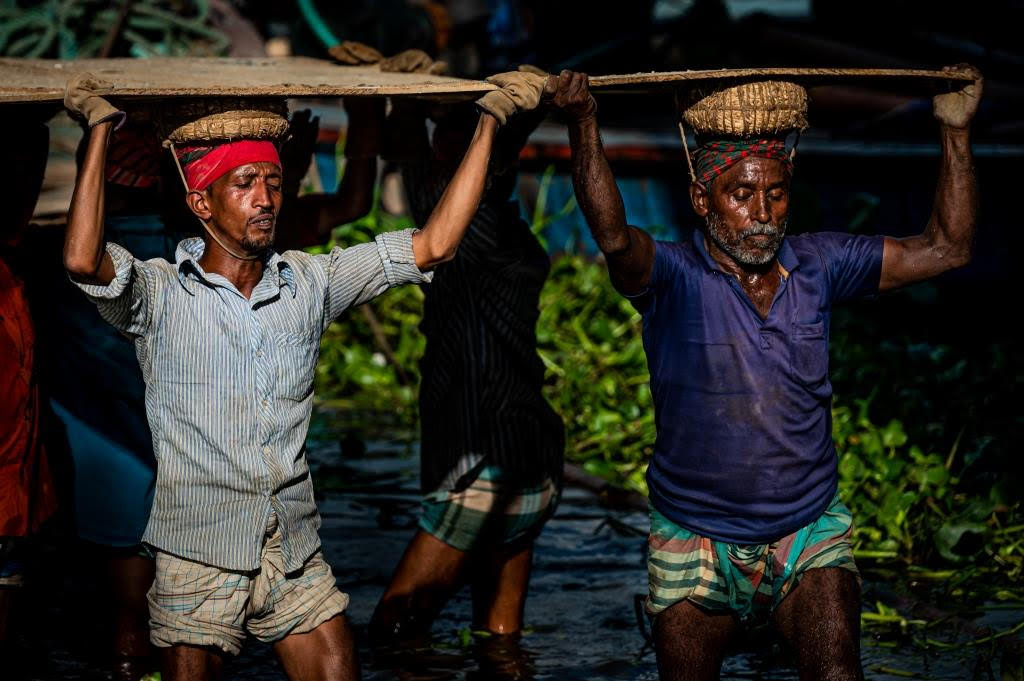
Their feet: They tirelessly bear the burden of this world roiled even though they are.
Earlier this month I was in Dhaka to attend a one on one photography workshop with an extremely talented Bangladeshi photographer G M B Aakash. As I was set to leave for Dhaka a student of mine remarked, “Comrade, tussi abroad challe ho” (Comrade, you are going abroad)? Nothing could have been more tragic for me than to feel like being ‘abroad’ in Bangladesh. I told my student friend – “I would just like to feel like being at home in Dhaka; like an overdue homecoming.”
My affliction here does not owe to any reason endogenous to me; it is simply for the reason that we are the same people either across our western border or the eastern border, united by a shared history extending over thousands of years. The borders are only 75 years old and it is my firm belief that if people across the sub-continent could have their way, the borders, as a barrier to the free intermingling of people, would disappear sooner than later.
I need to admit here that Bangladesh did not disappoint me even the slightest. Upon arrival as the immigration official at the airport saw my passport a smile crossed his face. “Welcome to Bangladesh Sir. You are from JNU! It’s a great university; at least the greatest in South Asia and you are in a great profession.” This was no coincidence, for on my return another officer at the immigration said much the same thing.
But this was not the first time that I earned plaudits from a Bangladeshi in Bangladesh for simply being part of JNU. There is a small village ‘Dawki’ on Indo-Bangladesh border in south-east Meghalaya where the Umngot river forms a lake on the Indian side before flowing across the border into Bangladesh. It is a picnic spot where the common people seemed to have sway over the paramilitary Border Guards right on the border, both in India and Bangladesh. I had been to the place in December 2017.
A rather modest nylon rope, stretched across the river to mark the border, seemed to bear the audacity of dividing thousands of years of our shared history into India and Bangladesh. But the people were equally intent, quite spontaneously rather than by particular design, to mitigate the ‘audacity of the rope.’ Even as the hawkers on either side did brisk business by selling snacks to customers from either side, selfies were being clicked by picnickers from the two countries on either side of the ‘rope’, inside each other’s country.
It is there that I met a group of Bangladeshi students and some lawyers practicing in the Bangladesh Supreme Court. Mere mention of being a professor at JNU earned me generous plaudits instantly along with an invite for a selfie in Bangladesh. The ‘rope’ was only a hapless witness to the will of the people.
I would let the plaudits rest here.
Before my arrival in Bangladesh, Aakash had asked me to come prepared with a wish list of what I would like to photograph. ‘People’ is all that I had in my mind. I told him that my interest was in the genre of photography where people would speak through my photographs, and so it was. We went almost exclusively to working class areas and among the workers during the workshop. They welcomed me with generous smiles and rarely declined a pose for the camera. Moreover, that I was from India elicited a measure of excitement and a lot of respect on their part – something, I believe, we in India need to learn from.
What follows are some of the impressions I have carried back with me. I just wish that these manage to nudge our opinions a little.
(The author is Assistant Professor, Centre for Social Medicine and Community Health, Jawaharlal Nehru University-JNU)
[All photographs by Dr Vikas Bajpai during a recent photography workshop with Bangladeshi photographer G M B Aakash.]

And the hands that can hold up the sky, even though bonded into slavery of circumstances they are.




Marching on.

What might not shake on earth if only these limbs were to begin marching for their own salvation? Unfortunately, their oppressors, at least for now, seem to realize this truth far better than the bearers of this potential.

Laborious pillars.


Burden off loaded to begin another round and the process goes on for at least eight hours a day.


Life rolls on and there seems no escape.

An abiding picture of dignity: She is Anara Begom at Karwan Bazaar wholesale vegetable market, Dhaka.

Anara Begom’s husband was killed in Rawalpindi at the time of Bangladesh liberation war. She raised her children single handedly, and now that they are all married, she is left alone to fend for herself as her offspring can themselves manage only a hand to mouth existence.
We found Anara Begom tucked in a corner of Karwan Bazar sitting with an assortment of around a dozen pieces of vegetables on a mat waiting for a customer. All of her capital was worth no more than 10 to 15 takas, or so was her expectation. But who would buy this, one might wonder? As it was to be found, at Karwan Bazar there are layers within layers. There are big wholesale traders, who supply the big and small retailers. In the transaction some vegetables fall off the sacks, or those that have started rotting in parts are discarded. Such vegetables are collected by people like Anara, washed, their decayed portions removed, and then sold to other poor people like her, of which there isn’t a dearth. Anara Begom thus manages to ward off the indignity of having to beg.

As she steals a nap her mate keeps a strict vigil.

Stealing a smile from the shadows of life; a headload worker, Karwan Bazar wholesale vegetable market, Dhaka.

Ferrying a headload of goods as he does at Karwan Bazaar, life is a day to day grim struggle for this worker.

Royal bath: This worker enjoys a refreshing bath after the day’s hard work at Gabtoli cattle market in Dhaka.

The man and his machine: As I stood angling for this shot, I was incidentally reminded of Ritwik Ghatak’s 1958 film ‘Ajaantrik.’


All in a day’s toil.


All in a day’s toil.

Bangladesh is a land of mighty rivers. River Buri Ganga is the lifeline of Dhaka and the port at Gatboli is the busiest commercial port of the city handling major trade. Naturally then it is teeming with workers loading and unloading the ships. Nothing would exemplify better the adage – ‘living by the sweat of the brow only to get browbeaten’ as these workers do.

Lunch break at Gabtoli.

Worries galore.

Maimoona manages her tiny ‘dhaba’ (food stall) to provide cheapest possible food for the laborers at Gabtoli.


The angry young man – Who will channelize his anger?

Rahimul and

Khaleeda ferry coal from the ships ……..

Each basket of coal they ferry carries around 40 kg of coal which is to be offloaded at the depot that is around 100 meters from the ship. Each round trip earns them 3 takas and the count of the trips is kept by plastic tokens handed to them after each trip. Just calculate how many trips they would be making to earn a daily wage between 500 to 800 takas. It’s a sheer feat. Isn’t it humbling that they still managed a smile to make a great photograph. Notice the kohl in Khaleeda’s eyes.

The proletarian Rambo.

You would have heard of descriptions like ‘Colgate smile’, ‘Binaca smile’ and ‘Cibaca smile’ for flashy smiles. His smile was twice as glorious as all three of them put together.


A genial Hercules.
Bilal Hossein was tall and muscular with broad shoulders on which rests the weight of many responsibilities. He said that he toils hard so that his children can get all the education they need. I intervened just in time to prevent him from wiping out the beads of sweat on his countenance. The results are what they are. After the photograph was taken, Aakash asked the tea shop owner on site to open two one liter bottles of seven up for Bilal and his compatriots to quench their thirst.


As dusk cast its deep shadow over Gabtoli it was time to bid adieu.